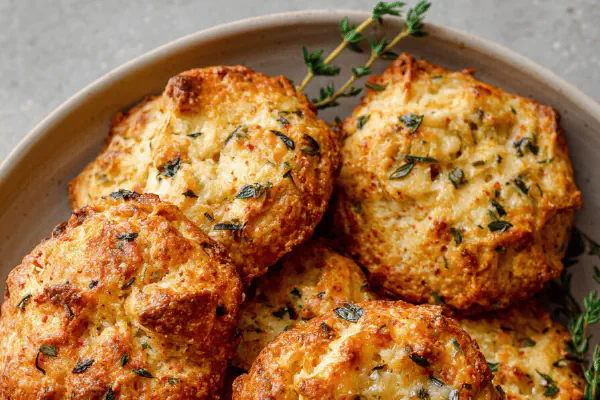Twisted Gruyère Thyme Biscuits

By Emma
Certified Culinary Professional
Ingredients
- 200 ml spelt flour, sifted
- 150 ml grated Gruyère cheese
- 3 ml smoked paprika
- 2 ml salt
- 100 ml cold extra-virgin olive oil
- 50 ml cold water
- 5 ml fresh thyme leaves, chopped
- 5 ml lemon zest, finely grated
About the ingredients
Method
- Preheat oven to 175 C (347 F). Line two baking trays with parchment; set aside.
- Mix spelt flour, Gruyère, paprika, salt, thyme, lemon zest in large bowl. Toss lightly, break any cheese clumps with fingers.
- Drizzle in olive oil, work with fingertips until coarse crumbs form. No food processor here; control is key. The texture should feel sandy, no lumps.
- Add cold water gradually. Stir gently to start, then press dough into a ball once it barely holds. Avoid overmixing—spelt is fragile.
- Wrap dough in cling film. Flatten into a disc about 4 cm thick, chill minimum 2 hours. Extra firm dough is easier to slice thin.; Freeze if needed—wrap well, slice from frozen after 20 min thaw.
- Remove dough disc from fridge. On floured surface, roll out gently, 5 mm thickness. Resist urge to go thinner, they'll crisp up too much.
- Cut into rounds approx 3–4 cm diameter. Can use small cookie cutter or sharp knife for rustic shapes. No overcrowding; biscuits need room to brown evenly.
- Transfer to trays. Prick tops with fork if dough puffs up too much. Watch oven carefully—toothpick inserted should come out clean but crumbs, not doughy.
- Bake one tray at a time, about 13–16 minutes. Look for edges turning deep golden; centers slightly paler but firm. Remove, cool on tray a few minutes before transferring to wire rack.
- Cool completely; biscuits crisp as they cool. Store airtight up to 3 days or freeze after cooled. Reheat briefly in warm oven to revive crunch.
Cooking tips
Chef's notes
- 💡 Chill dough minimum 2 hours or more. Spelt flour fragile; warm dough means crumble mess. Keep hands cold, wrap tight. Roll 5 mm thick—thinner burns edges fast, thicker puffs losing crisp. Patience pays here.
- 💡 Mix dry first. Toss Gruyère clumps apart—no lumps that melt weird in oven. Olive oil drizzle slowly, fingers work crumbs best. No food processor unless you want paste. Texture sandy, no lumps, good crumb control.
- 💡 Cold water added gradually; dough barely holds shape—overmix and spelt loses crunch, gluten activates too much. Press dough not knead. Dough fragile but firm after chilling. Freeze wrapped tight for longer storage; slice frozen with sharp knife.
- 💡 Watch baking closely. Temperature varies, don’t trust time blindly. Edges amber, centers pale and firm—not doughy, not burnt. Fork prick tops if puffing too much, stops bubbles, gives rustic touch. Oven sounds change from quiet to crackling when close.
- 💡 Lemon zest lifts earthiness, thyme fresh not frozen for herbal burst. Smoked paprika mild heat, swap cayenne or chipotle for deeper kick. Butter cubes can swap olive oil for flakier texture but adjust chill time; oil keeps dough softer yet crisp.
Common questions
How do I avoid dough crumbling?
Keep dough cold. Spelt flour delicate, warms fast from hands. Press gently. Chill 2+ hours minimum. Avoid overmixing or kneading; fragile structure breaks. Wrap tight to not dry out. Cold water only; warm makes tough.
Can I use regular flour instead of spelt?
Yes. Texture less nutty, fluffier. Baking time slightly different, keep eyes on edges color. Taste changes; less earthiness. Still chill dough same. Good if spelt unavailable but expect lighter bite.
Why do my biscuits puff unevenly?
Could be thickness varies or warm dough. Fork prick puffs to vent steam. Dough firmness affects rise; too warm means bubbles growing uneven. Roll on floured surface with light lifts to avoid sticking but keep thickness consistent.
Best way to store leftovers?
Airtight container after cooling only—warm traps steam, soggy biscuits. Can freeze fully baked or freeze dough rolled and sliced. Thaw frozen dough 20 min before baking. Reheat briefly in warm oven, crunch revives fast.



